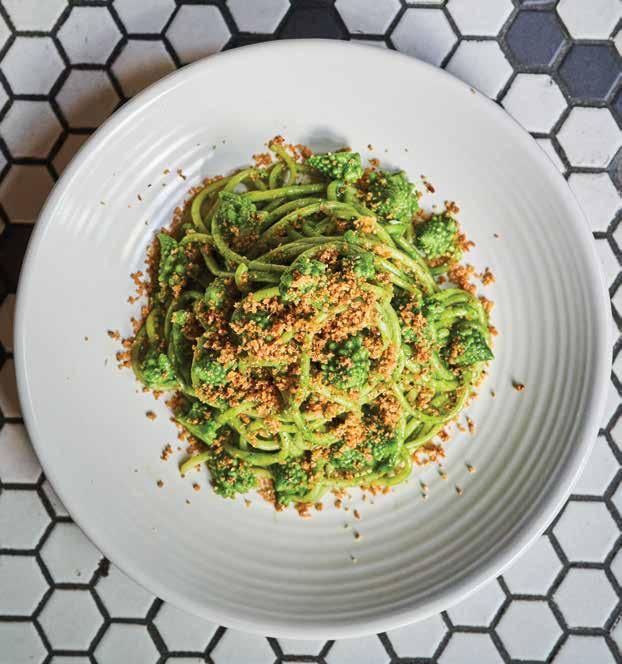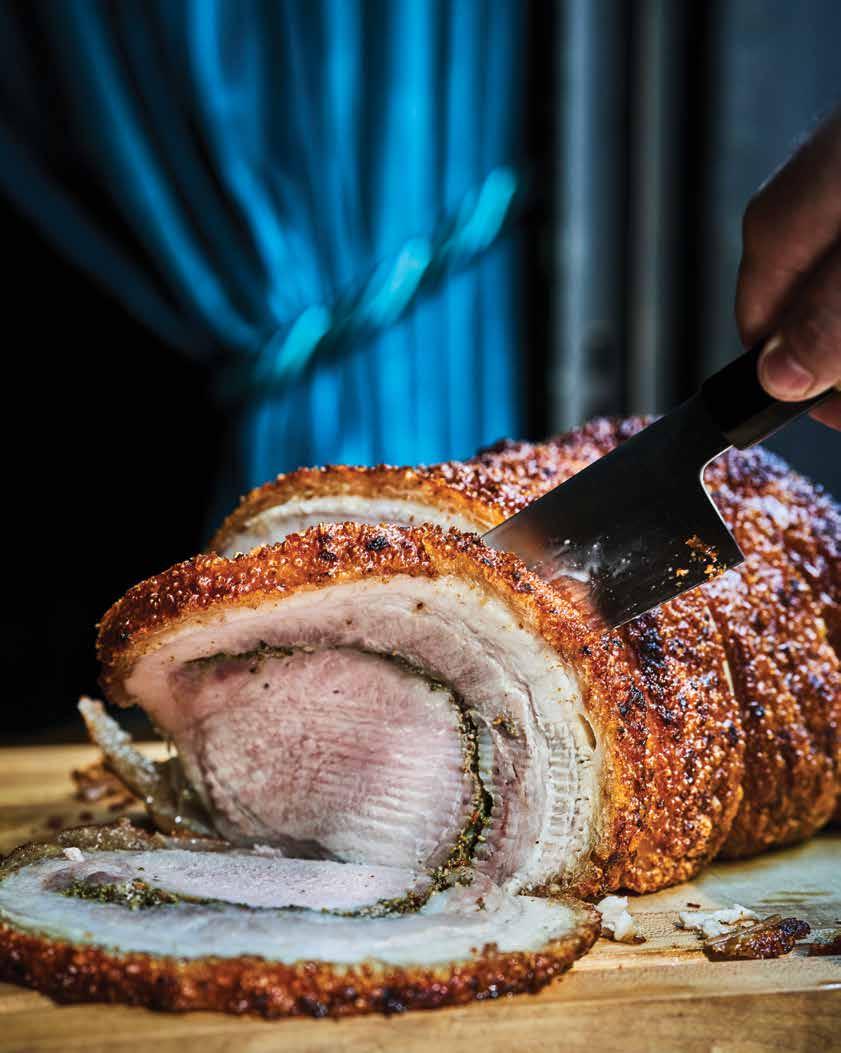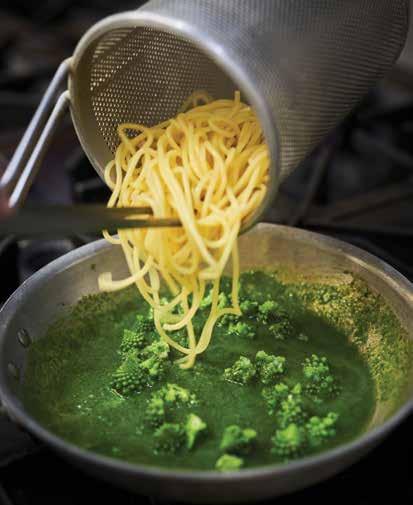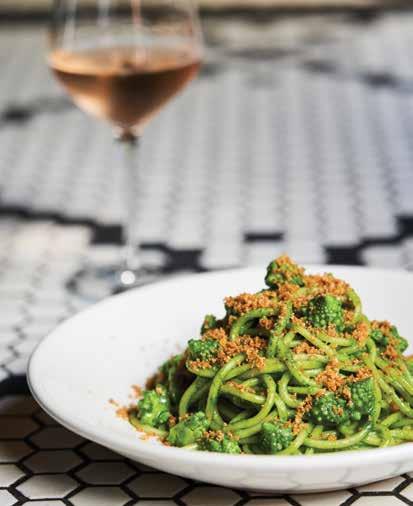
10 minute read
ROMAN HOLIDAY
from Hearth and Home 2020
by SunsetMag
ROMAN
Thomas J. Story photographs by

HOLIDAY Chef Evan Funke, L.A.’s prince of porchetta and pasta, cooks a holiday feast inspired by the flavors of the Eternal City.
As L.A. nearly imperceptibly tipped from summer to fall, chef Evan Funke gave the city an early holiday gift: a pop-up restaurant residency in Hollywood inspired by the pizzerias and osterias of Rome. Over the years, Funke has risen to fame as a master of Italian cuisine, most notably with his restaurant Felix in Venice, a transcendent temple to handmade pasta. His new spot in Hollywood, in a romantic little open-air passageway—a mini piazza if you will—is just what Angelenos needed some eight months into a grueling chapter in this city’s history. The restaurant is charmingly, hopefully, called Fingers Crossed. Here he serves his version of Roman food: simple pastas and pizzas and the occasional roast. For our holiday issue he returned to the dish that first drew him acclaim here in L.A. when he served it from a food truck: porchetta, that fennel-and rosemary-scented pork roast ringed with crunchy skin. He served it on sandwiches way back when, but for this menu he went big, with a twelve-pounder that’s worth the effort and will take you from the holidays and possibly into the New Year.
PORCHETTA
SERVES 12 / 6 HOURS
“It’s nearly impossible to cook porchetta for a single meal, let alone a single meal for a small group. This large roast will provide multiple meals with many uses like sandwiches, cold cuts, pizza, and it can be cubed up and served with pasta. Speak with your local butcher to inquire about a pork loin, skin on, belly attached. When it comes to seasoning, be liberal with the salt, it will need to penetrate the meat. I’ve provided a salt variance here depending on the size of the pork section. You’ll need a digital thermometer to get this just right.”
10-to-12-pound section of pork loin, skin-on, belly attached ½ to ¾ cup kosher salt 5 large garlic cloves, grated Whole black peppercorns 1 Tbsp fennel pollen 1 Tbsp red chili flakes 1 cup finely chopped rosemary 1 lemon
1.
2.
3.
Preheat an oven to 275°F. Lay the porchetta on a flat counter or large cutting board skin side down, with the loin closest to you. With a thin sharp knife, poke holes in the meat, about ¼ inch deep. Be careful not to cut all the way through. Season the porchetta: Sprinkle
4.
5.
the porchetta liberally with kosher salt. Massage garlic into the meat. Crack black pepper evenly across the entire surface, about 40 turns on a hand grinder. Sprinkle fennel pollen, chili flakes, and rosemary across the entire surface. Zest the lemon skin with a fine grater and sprinkle evenly across pork. Roll the porchetta: Rolling the loin away from you, connect the top of the loin to the bottom of the belly making a roll. Slide a doubled length of butcher's twine under the roll and cinch a knot 2 inches from the edge of the roll. Repeat every 2-3 inches making sure the twine is taught and the knot tight. Cook the porchetta: Place the porchetta on the sheet tray with a roasting rack. Add 1 cup of water to the bottom of the tray. Cover tightly with the aluminum foil, this will help to gelatinize the skin through steam. Bake in the oven for 90 minutes. Remove the foil. Increase the temperature of the oven to 325°F and cook for 90 minutes. Fat will have rendered into the pan and must be removed. To safely drain the rendered fat, place a damp kitchen towel on the open
6.
oven door and place a medium sized steel bowl on the towel. While holding the sheet tray with oven mitts, slide the sheet tray toward you and gently tilt the tray so that the fat runs towards the corner of the tray and into the receptacle. Remove the rendered fat in this manner 1 or 2 times during the cooking process, being very careful as the pork fat is extremely hot. Check the internal temperature of the porchetta by inserting the thermometer into the center of the loin, it should be around 90–100°F. Degrease the tray and increase the temperature of the oven to 450°F and roast for 30 minutes. Check the internal temperature, it should be climbing towards 120°F. Roast for an additional 30-45 minutes, checking the internal temperature intermittently. Cook the porchetta until it reaches 140°F. At this point the skin should be bubbly and the belly fat will have rendered into the sheet tray. Be very careful of the rendered fat when removing the tray from the oven. Allow the porchetta to rest for 30 minutes before slicing.


FOCACCIA DI ZUCCA
SERVES 6 / 2 HOURS
While foccacia can be dense if you’re not careful, Funke’s is airy and delicate, and shot through with a vivid orange thanks to his clever use of squash juice rather than a heavy purée. Puréeing, straining, and diluting the liquid adds a step but for focaccia fans and bakers it’s worth it.
3 cups cleaned peeled and diced kuri squash 1 ²/₃ cups water ½ Tbsp honey 4 tsp dry instant yeast 5 cups all purpose flour scant 4 tsp sea salt 1 cup extra virgin olive oil Coarse sea salt for finishing Chopped fresh rosemary, optional
1.
2.
In a high speed blender, blend the cleaned squash and water until very smooth. Strain the juice though a fine mesh strainer, taking care to not press the puréed squash through the sieve. Reserve the liquid and reserve the purée for another use like soup. In a shallow pot on medium heat, bring the juice to a simmer for 5 minutes to remove the starchiness of the squash juice. Cool the juice in a metal bowl set over ice until very cold.
3.
4.
5.
With a digital scale, weigh the juice and add water until the total liquid is about 16 oz. Note that if you have 2 cups of squash juice, there is no need to add water. In a mixer with a dough hook, combine the juice, yeast, honey, and half the flour. Mix on low until the mixture is pancake batter consistency. Add the salt, olive oil, and the remaining flour incrementally until all the flour is combined. Mix on medium speed for 8–10 minutes until the dough is smooth and elastic. Remove the dough from the mixer to a lightly floured surface and cover with plastic. Allow the dough to rest for 5 minutes. Meanwhile, grease a deep baking tray with ½ cup olive oil. An aluminum turkey pan works great for this or two large Pyrex baking trays. Note: If using two smaller vessels, you will need to divide the dough in half before shaping.
6.
To shape the dough, pull the farthest edge of the dough, folding under and towards you. Rotate the dough a quarter turn and repeat the fold, under and toward you. Repeat the fold 2–3 more times, shaping the dough into a tight round ball. The surface of the dough should be taught and smooth. Place the dough in the baking tray and cover tightly with plastic wrap. Place in refrigerator and let rest overnight. The next day, remove the dough from the refrigerator, remove the plastic wrap. Preheat the oven to 425°F (preferably with convection). With your finger tips, dimple the dough deeply and evenly. Allow the focaccia to rest 10 minutes and dimple again, spreading the dough gently with your fingertips to the corners of the tray. Repeat one more time. Cover the focaccia with a damp, lightweight towel or plastic wrap and proof in a warm area of the kitchen for 1–11/2 hours or until it doubles in size. Bake the focaccia for 8–10 minutes rotating the focaccia at the 7-minute mark. Remove the focaccia when the surface of the crust is deep golden brown. Cool for 15 minutes, serve warm with coarse sea salt, rosemary, and a healthy drizzle of olive oil.
BUCATINI AL PESTO DI BROCCOLO ROMANESCO
SERVES 5 / 1 HOUR
"Although not strictly traditional, this pesto provides an excellent complex backdrop for the additional romanesco florets. We substitute shards of crisp fried bread crumbs for finishing cheese for deep contrast of texture."
1 large leafy bunch rapini ³/₈ cup pine nuts 2 large garlic cloves 12–15 anchovy fillets ½ cup grated pecorino romano ½ cup plus 2 Tbsp grated
Parmigiano-Reggiano 1¼ cup extra virgin olive oil 2 Tbsp grated pecorino romano 1 head romanesco broccoli 1 pound dried bucatini Fried bread crumbs
Preheat the oven to 300°F. Spread the pine nuts evenly in a single layer on a small baking tray. Toast the pine nuts for 6–8 minutes or until deep golden. Remove from the oven and set aside to cool. Bring a large heavy-bottomed pot of water to boil, season aggressively with salt. Meanwhile, trim the romanesco by separating the conical florets and reserve. Trim the bottom ¼-inch off of the stems and save the center mass and trim for another use like soup. Wash and trim the bottom ¼-inch of the rapini and discard. Prepare an ice bath by filling a large bowl with ice cubes and water. Add rapini to boiling water and blanch for 2–3 minutes or until bright green. Remove rapini from water (turn down the heat, but keep the water on the stove, you’ll need it to cook the romanesco) and immediately add it to ice water to shock it and stop the cooking process. Once rapini is
5.
6.
cool, wrap it in a clean kitchen towel and twist to wring out all the water. Roughly chop the rapini and set aside. Return water to a boil, blanch the romanesco florets for 2 minutes and repeat the same cooling steps. In a food processor combine the garlic, olive oil, anchovy, pine nuts and cooked rapini, and blend until bright green and semi smooth. Add the grated cheeses (reserving 2 tablespoons pecorino romano) and pulse to incorporate. Taste and adjust seasoning. Remove from food processor. To finish the dish: Bring a heavybottomed pot of water to a boil, season it with salt so that it tastes like a soup, not the ocean. Add the bucatini. Meanwhile, place a sauté pan on medium heat and add 1 tablespoon extra virgin olive oil. Once the oil is shimmering, add the romanesco florets and cook for 1 to 2 minutes. Remove the pan from the heat until the pasta is just about cooked. Once the pasta is al dente, about 8 minutes, drain the pasta and reserve ¼ cup or so of the pasta water in case you need a splash to moisten the pesto. Add the pesto to the pan, add pasta, toss and stir until well coated. Sprinkle in 2 tablespoons pecorino romano and a splash of the pasta water to bring everything together. Transfer pasta to a warm serving platter, sprinkle fried bread crumbs abundantly over the pasta. Serve immediately.
Next Level Bread Crumbs
"You can purchase premade bread crumbs but I prefer to use bread that is a few days old. You’ll need about ½-cup of bread crumbs for the pasta dish."
•Preheat the oven to 300°F. •Tear 4 slices of day old bread into small bits and layer it on a baking tray.
Toast the bread to a deep gold, about 30–45 minutes. •In a food processor, chop the bread until it is evenly coarse. •In a wide sauté pan, add 2 tablespoons good olive oil and a smashed clove of garlic. When the oil is shimmering, add the bread crumbs and toss or stir to coat the crumbs in oil. •Cook on medium heat for 3-4 minutes, moving constantly. •Once browned, remove the bread crumbs from the pan and spread them on a sheet tray to cool. •Reserve.


1. Adding cheese to the sauce before the pasta pre-layers flavor. 2. Finishing the pasta in the pan lets it soak up the sauce. 3. The trick to getting that vivid color is to cook the rapini just until it turns bright green and then shock it in an ice bath. 4. Bread crumbs add the final crunchy touch.












